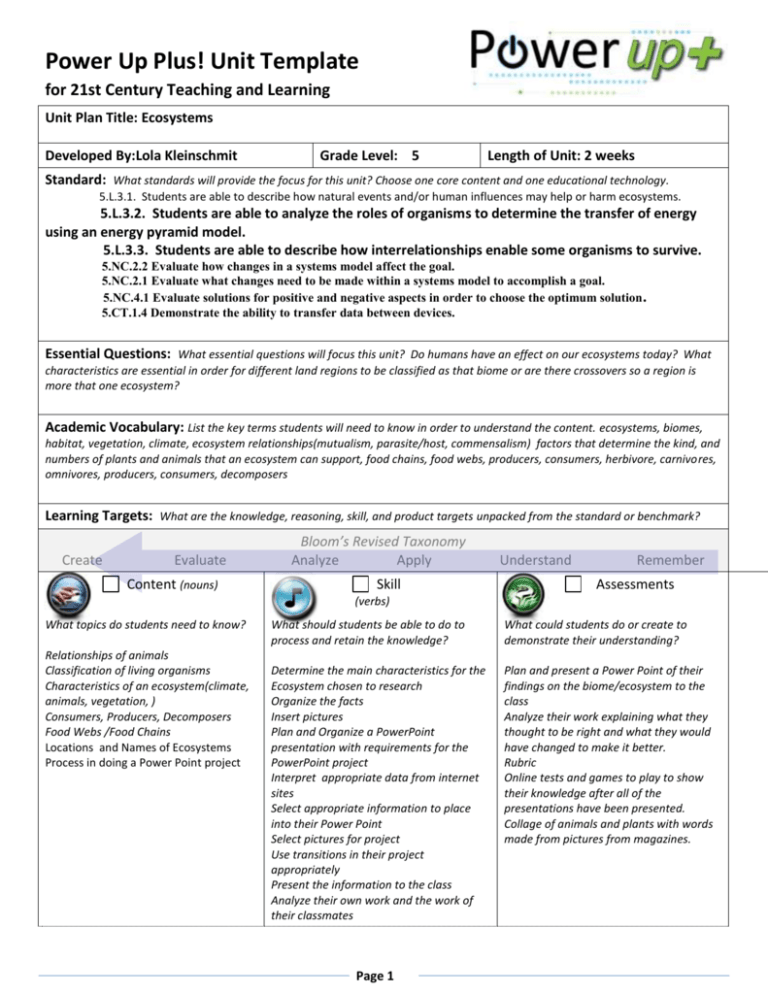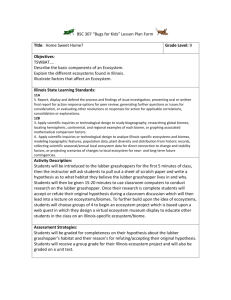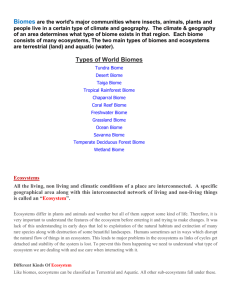LolaKleinschmit_Unit 2
advertisement

Power Up Plus! Unit Template for 21st Century Teaching and Learning Unit Plan Title: Ecosystems Developed By:Lola Kleinschmit Grade Level: 5 Length of Unit: 2 weeks Standard: What standards will provide the focus for this unit? Choose one core content and one educational technology. 5.L.3.1. Students are able to describe how natural events and/or human influences may help or harm ecosystems. 5.L.3.2. Students are able to analyze the roles of organisms to determine the transfer of energy using an energy pyramid model. 5.L.3.3. Students are able to describe how interrelationships enable some organisms to survive. 5.NC.2.2 Evaluate how changes in a systems model affect the goal. 5.NC.2.1 Evaluate what changes need to be made within a systems model to accomplish a goal. 5.NC.4.1 Evaluate solutions for positive and negative aspects in order to choose the optimum solution . 5.CT.1.4 Demonstrate the ability to transfer data between devices. Essential Questions: What essential questions will focus this unit? Do humans have an effect on our ecosystems today? What characteristics are essential in order for different land regions to be classified as that biome or are there crossovers so a region is more that one ecosystem? Academic Vocabulary: List the key terms students will need to know in order to understand the content. ecosystems, biomes, habitat, vegetation, climate, ecosystem relationships(mutualism, parasite/host, commensalism) factors that determine the kind, and numbers of plants and animals that an ecosystem can support, food chains, food webs, producers, consumers, herbivore, carnivores, omnivores, producers, consumers, decomposers Learning Targets: What are the knowledge, reasoning, skill, and product targets unpacked from the standard or benchmark? Create Evaluate Content (nouns) Bloom’s Revised Taxonomy Analyze Apply Skill Understand Remember Assessments (verbs) What topics do students need to know? Relationships of animals Classification of living organisms Characteristics of an ecosystem(climate, animals, vegetation, ) Consumers, Producers, Decomposers Food Webs /Food Chains Locations and Names of Ecosystems Process in doing a Power Point project What should students be able to do to process and retain the knowledge? What could students do or create to demonstrate their understanding? Determine the main characteristics for the Ecosystem chosen to research Organize the facts Insert pictures Plan and Organize a PowerPoint presentation with requirements for the PowerPoint project Interpret appropriate data from internet sites Select appropriate information to place into their Power Point Select pictures for project Use transitions in their project appropriately Present the information to the class Analyze their own work and the work of their classmates Plan and present a Power Point of their findings on the biome/ecosystem to the class Analyze their work explaining what they thought to be right and what they would have changed to make it better. Rubric Online tests and games to play to show their knowledge after all of the presentations have been presented. Collage of animals and plants with words made from pictures from magazines. Page 1 Planning the Learning Experiences: What learning experiences will equip students to demonstrate the targeted learnings? In other words, what instructional strategies can be used to facilitate students’ ability to successfully complete the assessments? Page 2 Learning Cycle Understand the concept of Ecosystems Know that ecosystems and biomes are related Realize the relationships that animals, plants, climate, and the topography have in an ecosystem and how they depend on each other See the effect that humans can have on ecosystems, helpful and harmful. Research and organize information needed to complete the assignment Design and construct a Power Point that can be used to teach other students about the ecosystem he/she is researching. Tech Integration Research the internet sites using Wonder Wheel on Google to collect information on the four topics for their graphic organizer to collect information for the Power Point. Create a Power Point Presentation to present to the class their knowledge of the Ecosystem Create a Wordle coping two paragraphs from an internet site to see the important vocabulary Work at achieving quality work, that getting done to be done is not the goal of this project Reading Strategies Before _Preteach vocabulary Learn the names and locations of the Ecosystems and biomes Discuss the characteristics of the biomes after each child has researched the biome. ___________________________ ____________________________ ____________________________ ____________________________ During Use a graphic organizer to collect the date which the child thinks is important to that ecosystem. We tried 3 different kinds from the Reading Quest.com to see which ones worked the best Check the understanding of the content with individual meeting with the teacher ___________________________ _____________________________ _____________________________ _____________________________ After _Using a rubric, check the content and understanding of the biome they have through the way the information was presented in the Power Point. Answer any questions asked by the instructor or any of the other students to clarify the content. ____________________________ _____________________________ _____________________________ _____________________________ Learning how to self-evaluate and peer evaluate the completed projects. Know that reports are not the only way to learn about a topic, and books are not needed all of the time. 21st Century Skills: X X X Page 3 Digital Age Literacy Inventive Thinking Effective Communication High Productivity Where: How will you let participants know the expected outcomes/purpose of the work? I will tell the students what I expect and give them a check list of the topics that must be included in the content and also in the Power Point. This will be explain with the use of two rubcis-one for content and one for the Power Point. Hook: How will you engage participants? Each student has a computer. Two people work together to collect the necessary information. Then each student will design and write the Power Point assignment to present the information. Explore: What activities will provide experiences and explorations to equip participants for completing the final performances? Once the information was collected, games were played on the computers to reinforce the knowledge(Jeopardy, matching, word finds) A couple of Power Points were also shown to demonstrate the parts of a Power Point and how they are made. A senior student demonstrated to the class on the procedure, parts, and steps in making a power point as none of the students had never done a Power Point before. The students then worked on their projects. They chose styles, entered knowledge they wanted to present and then added pictures. After they completed this, they worked on transitions, sound, and order until the project was complete. Reflect: In what ways will participants be encouraged to dig deeper through feedback and self-assessment? We watched the Power Points and critiqued them as a class, themselves, and the teacher or aides. Then the students were allowed to change anything they chose to change before the final project was shown again and scored by their peers and the teacher. Exhibit: How will participants show their level of understanding? Evaluate their strengths and challenges? Individual student/teacher meetings were met with asking questions, discussing content, and clarifications of the content before a test was given. The final project was an art Collage project in which the pairs of students collected pictures of animals, vegetation, and scenery of their perception of the biome. Then words were added that depicted mains words from wordle that was made. All of the students had a great understanding of the content. The biggest challenges were the time I thought would take to complete the Power Points took longer for most of the students. Those that finished started working on the collage until all of the projects were completed. Games were also played from internet sites and others helped students that were struggling with the project. Page 4 Lessons/Activities: Use this space to describe sequence of learning activities, materials/resources needed, time frames, etc. 1. 2. 3. Viewed internet sites for the content of the ecosystem Taught the vocabulary and discussed the main biomes or ecosystems in the world. Chose the biome each chose to research, learn information on, present to the class, and teach the other students about their biome. 4. Researched and collected information on a graphic organizer (four areas of main ideas and at least four details about each topic. Main ideas included 1. Land descriptions 2. Climate 3. Plants or vegetation 4. Animals Each student could include any other interesting information they chose to include. 5. They had to have the details approved by the teacher or the aide, or further information had to be researched. Independent interviews with the teacher were held to make sure the content was understood. 6. Started working the Power Point 7. Presented the first run through for critiquing by themselves, peers, and instructors. 8. Made improvements on their project 9. Final view of their Project with peer editing and instructor editing. 10. While everyone was completing their project, the collages were started and games were played to reinforce their knowledge. Time frame Instruction—3 days Research –4 days Power Points 5-7 days Collages—5 days Modifications: In what ways will the learning experiences be differentiated to meet student needs? Far Below Standard Approaching Standard Meeting Standard Exceeding Standard The number of facts was reduced to two details. Help was given to these students with typing and construction of the Power Points. The number of slides was also reduced if they chose. Reading was done of the internet sites to the students when they needed help and then they told the facts he/she wanted included with someone doing the main writing for them before they worked on the Power Points. Student aides who knew how to make a Power Point helped those who needed help Some help was given to these students if they needed help. Three of these students took the computers back to the round table and my class aide sat at the table to answer their questions and guide them in doing their project. I walked around constantly giving help and giving encouragement to tweak up their work, dig a little deeper, and ask if they could do anything different that would make their project better. I constantly encourage them to tweak up the content, dig a little deeper, ask questions to see if he/she could find any other information that they don’t think the other students wouldn’t know, and see if the final project could be the best in the class. I also want these students to teach the other students what they know about Power Points so the other students can learn to make their projects better. Page 5








